Prince Edward Island, one of the three Maritime Provinces on Canada's Atlantic coast, includes a lovely landscape that evokes a Grandma Moses painting of rural New England. A prime attraction on the island is Prince Edward Island National Park, where the combination of some serious literary nostalgia and fine natural features create what amounts to two parks in one.
It's almost impossible for most of today's younger generation to imagine life without smart phones, the Internet and multi-channel HD TV. Electricity makes climate control in our homes and refrigerated storage of food easy, and little if any of that food comes from our own land.
The chance to glimpse life as it was over a century ago is one of the values of historical sites in some national parks, but not many locations have the chance to offer history in a package with as much nostalgic appeal as Prince Edward Island National Park.
PEI is a Popular Tourist Destination
"PEI," as the island is called by the locals, is a popular tourist destination for people from all over the world, and for good reason. While they're on the island, quite a few of those visitors make a stop at the national park's Cavendish unit and a fun "history lesson" at the house and farm that inspired one of the most successful novels of the 20th century.
Anne of Green Gables, by Canadian author Lucy Maud Montgomery, was published in 1908, has sold more than 50 million copies and has been translated into 20 languages. The book spawned a whole series of books by Montgomery, which in turn have been adapted as films, made-for-television movies, a television series, and musical and dramatic productions.
The stories about Anne Shirley, a fictional orphan raised on a farm on PEI in the late 1800s, were inspired by a house and landscape that's now included in the park as Green Gables Heritage Place. The author Montgomery grew up nearby on her grandparents' farm, and spent considerable time at a house now known simply as Green Gables.
The Books That Inspired a Tourist Industry
An entire tourist industry has been developed on PEI around the characters in these stories, and there are numerous Anne-related attractions and activities scattered around the island. One of the key elements in the tales'the house known as Green Gables'is now protected and managed by Parks Canada.Visitors can view a short film and exhibits about the author's life and the Green Gables story, then join a short guided walk around the grounds.
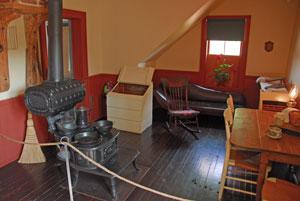
The house is furnished to evoke the era of the Green Gables novels. Jim Burnett photo.
A self-guided tour offers a look at most of the rooms inside the house, which is furnished to evoke the lifestyle and characters in the books and movies. Parks Canada staff are stationed throughout the house to answer any questions you may have.
A Different Kind of "Text"
Here's a glimpse at life when "text" referred to a printed page in a treasured book or newspaper, artificial light came from oil-powered lamps, and staying warm on a blustery winter's night depended on your proximity to that big stove in the kitchen...or how many hand-made quilts were piled on your bed.
Exhibits in a large barn near the house offer additional insights into life on a rural PEI farm in the late 19th century, and a popular spot for photo ops is a horse-drawn buggy parked between the barn and house. The horse has the year off, so tourists are welcome to climb aboard for a memorable "what I did on my summer vacation photo."
The Natural Setting is a Big Part of the Story
The park also includes the natural setting surrounding the house that inspired the author, and short, easy hikes lead to sites fans of the Anne stories will recognize, including the Haunted Wood, the schoolhouse, Lover's Lane, Balsam Hollow and the babbling brook. Our visit was on an unusually warm July day, so we were glad we took the advice of other travelers and timed our visit for the first hours of the morning. That's a good tip for any day of the summer season, since this is a popular destination for bus tour groups.
Our 9 a.m. arrival and departure before noon allowed a pleasant visit with minimal crowding. That three-hour visit allowed ample time to take the tour, see the house and grounds, and stroll the two primary trails. If you'd like to make only one of the short hikes, I'd suggest the Balsam Hollow trail, a 0.6-mile loop that begins near the house as "Lovers Lane" and then continues into Balsam Hollow.
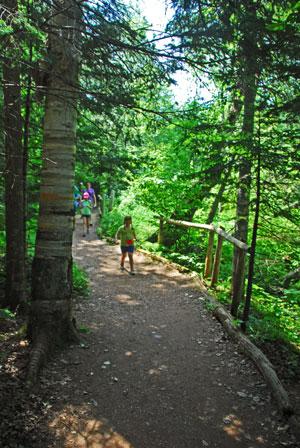
The Balsam Hollow Trail provides an easy stroll through deep woods. Jim Burnett photo.
This route runs through a dense forest canopy along and near a creek bottom; large ferns and gently flowing water add interest to the woods. Interpretive signs along the way offer information about the habitat.
This Haunted Wood is Pretty Mellow
The Haunted Wood Trail is a similar length (0.7-mile loop) and is also an easy walk, although there are some steps and short hills to negotiate, and we didn't find the woods or the route as attractive as the Balsam Hollow route. It's been a century since Montgomery used this area as the inspiration for her stories, so perhaps this patch of woods invoked a little more sense of adventure then than it did on a bright, sunny July day. An interpretive sign points out that the author "imagined these woods to be full of mystery, especially after dark."
A walk along the Haunted Wood Trail also points out another option'and a different kind of history'if members of your group aren't especially interested in Anne's story. About a third of the way along the trail, walkers suddenly encounter a brief break in the forest when they cross a section of the Green Gables Golf Course, designed and constructed in 1939 by Stanley Thompson, a renowned Canadian golf course architect.
A Bit of Golf Course History
One of the first public golf courses to be built on the island, it was restored and upgraded recently to reflect many of Thompson's original design concepts. The 7,000-yard course occupies a scenic setting against a backdrop of sand dunes in Prince Edward Island National Park.
The historic house and grounds in the park are open daily from early July until early September, with limited hours into the early fall. You'll find details about the operating schedule at this link.
The Other Face of PEI National Park
I suspect that quite a few locals visit Green Gables at least once, and include it on a list of places to see when they have guests, but Prince Edward Island National Park has plenty to offer beyond literary nostalgia for both area residents and visiting tourists. The park includes about 5,400 acres divided among three separate units spread along the northern shore of the island, and it's a summertime magnet for hikers, campers, beach-goers, nature lovers and perhaps most of all, bicyclists.
Described by the park website as "A Cyclist's Dream," the park offers 11 cycling trails, ranging in length from the easy Clark's Lane Trail (0.5 miles one way) to the 6-mile (one way) Gulf Shore Way East. These routes won't likely interest long-distance bikers, but they appear to be a bonanza for families or other riders who would enjoy a variety of fairly easy routes. If you'd prefer to walk rather than pedal, the park provides plenty of opportunities on 15 hiking trails, most of which are described as "easy." Some of these routes are shared with cyclists; others are restricted to foot travel only.
A unique natural experience away from the sometimes busy Cavendish area is the park's Greenwich Unit, which contains "an extensive and fragile coastal dune system, wetlands and various natural habitats in which numerous rare plant species are found." Three trails (0.75 to 2.8 miles in length) offer a chance to explore this area, which includes "unusually large and mobile parabolic dunes with their associated counter ridges or Gegenwälle. This phenomenon is very rare in North America."
Swimmer-Friendly Northern Beaches
An island at these northern latitudes may seem an unlikely place to spend time on the beach, but PEI boasts it has the "warmest waters north of the Carolinas," and swimming and other varieties of "fun in the sun" are popular activities here. The park offers seven supervised beaches, and surf guards are on duty from late June until late August. Brackley and Stanhope Beaches offer supervised swimming, accessible beach access and designated parking for those with limited mobility, and special beach wheelchairs are available at both locations.
There are plenty of places to spend the night on Prince Edward Island, but if you'd rather include camping as part of your trip, the park has two developed campgrounds open to the public, and a third for organized groups. The campgrounds are open from mid-June through mid-September, and facilities range from full hookup RV sites to "unserviced" sites with access to washroom building having toilets and showers. Fees range from about $20 to $35 per night, depending upon the season and levels of service. During most of the season, all of these sites are included in the Parks Canada reservation system.
More Things to See and Do
The park website offers information about other activities, including kayaking and canoeing, bird watching, fishing, and picnicking. Although all park facilities are closed from fall through late spring, and trails are not maintained during the offseason, many areas are open for hiking, cross-country skiing and snowshoeing during the winter.
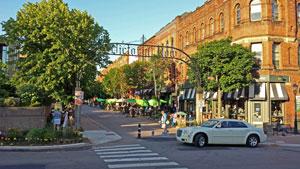
Charlottetown includes some attractive, pedestrian-only shopping and dining areas. Jim Burnett photo.
The capital of Prince Edward Island is Charlottetown, a delightful small city located about 25 miles southeast of the Green Gables area and the park's Cavendish unit. Charlottetown has a lot more to offer than you'd expect in a city of about 35,000 people, and we found it to be an excellent base of operations for our three days on the island.
PEI offers something for almost any interest, and you don't have to look very far to find lighthouses, outstanding seafood, and locally-grown produce. Any well-balanced diet includes some items from the dairy food group, so if you're on the island, you can cover that base with a serving of another island-produced favorite, Cows Ice Cream.
With a butterfat content of about 16 percent, this is the real deal in the world of ice cream, but you can work it off on a hike in the park. If the fictional Anne Shirley were living on Prince Edward Island today, I predict she'd be a fan of Cows. It would definitely be worth a trip through the Haunted Wood on a warm summer evening just to get a scoop.

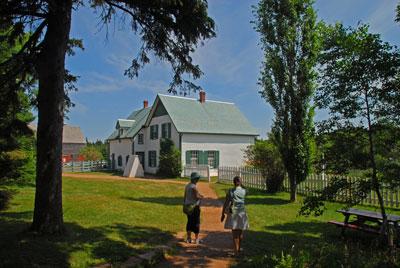
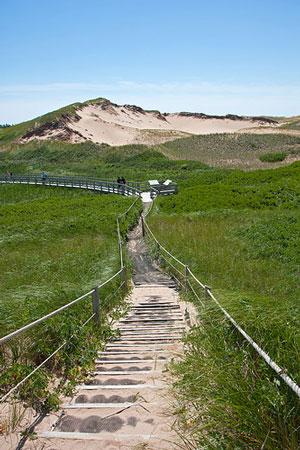


Add comment